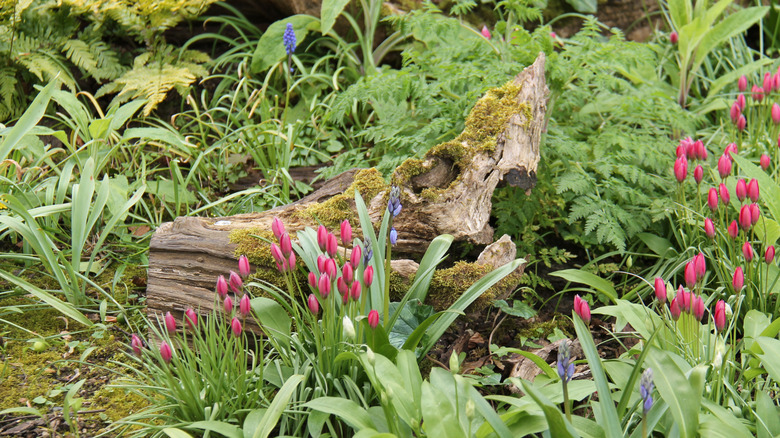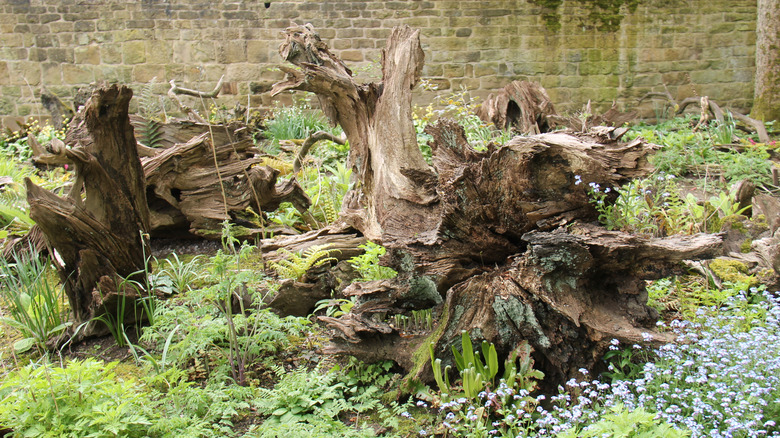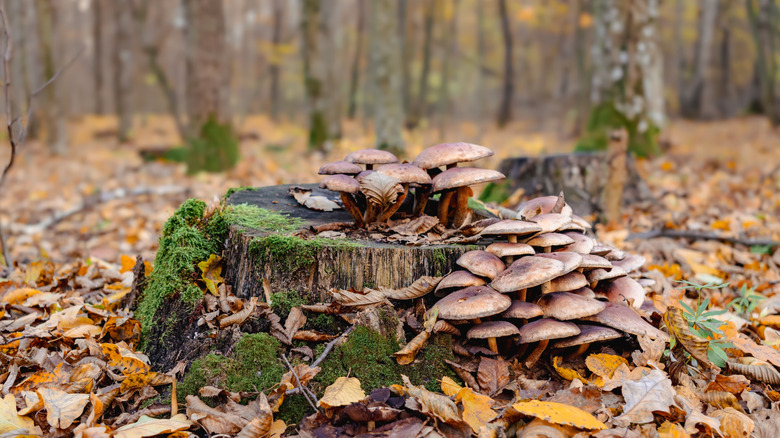A Stumpery Is The Beautiful Solution You Need For Filling The Shady Space In Your Yard
Growing a flourishing shade garden is often a challenge, and may lead some gardeners to look for alternatives to traditional garden beds. Increasingly, stumperies have become a popular solution to those tricky shady areas. What is a stumpery? Good question! Stumperies aim to create a decorative collection of stumps to create a natural-looking area, often interspersed with ferns. They are a great place to grow woodland plants and invite nature to work its magic in your garden.
This isn't a new trend. They date back to Victorian England and use unearthed stumps placed strategically to create a deliberate but naturalistic effect, with roots exposed for visual interest and nooks and crannies utilized for planting. They may be partially reburied to look more natural or overturned for more drama. Stumperies are ultimately about more than aesthetics, they also provide great habitat for wildlife. They will also change over time as the stumps decompose, fungi take hold, and the look and feel of the garden becomes more naturalistic.
How to start a stumpery
Start with a shady spot. Whether you have deep shade or dappled shade, a small corner of the garden, or a big woodland plot, a stumpery can work for you. Next, you will need some stumps or other pieces of wood. If you have existing stumps in your yard, great. If not, you can try reaching out to friends, neighbors, or even tree care companies to see if anyone has stumps you can use. If you don't have access to stumps with roots and all, look for driftwood, large sticks or branches in your yard, cut logs, or even stacked firewood.
Once you have gathered the materials, you can let your inner artist take over. You can go completely natural or arrange your stumps and wood in any kind of way you'd like. Set a scene or pile them up. Arrange them horizontally or lay them down vertically. It's up to you!
You can also decide what other features might work well in your stumpery. Create a small pond or add birdhouses to cater to the wildlife that will inevitably show up. Stumperies also make a great place to build bug hotels. You can hang lanterns from your branches, or nest a birdbath in the roots of your stump. There are many ways to make a charming birdbath, including tree stump DIYs.
Planting in a stumpery
The stumps may be the star of a stumpery, but plants are the supporting cast. Ferns make great groundcover in shady areas and are often featured in stumperies. However, any shade-loving, woodland plants will work well. To achieve a natural look consider native plants like woodland phlox (Phlox divaricata), which is hardy to USDA Zones 3 to 8. If phlox isn't for you, explore these 15 beautiful shade-loving flowers to consider adding to your stumpery. If you want to fill the area with plenty of contrasting foliage, plant hostas (Hosta spp.) of different colors and with variegated leaves. Hardy from USDA Zones 3 to 9, there is certainly an option for most gardens. Adding a native shrub like mountain laurel (Kalmia latifolia), which thrives in partial shade but can tolerate full shade, will add height and more habitat for wildlife. It's hardy in USDA Zones 4 to 9, but there are plenty of shade-loving shrubs to choose from.
Keep in mind that the ground is not the only place you can plant. Use the nooks and crannies of your stumps to place plants that might prefer drier conditions in crevices, while plants that like deep shade can be used in the shadows of your stumps. Remember that nature will do much of the work for you. Over time mushrooms, moss, and other features will appear. So be sure to leave room for the surprises that nature has in store. After all, the beauty of a stumpery is its natural feel. Letting nature take over is part of the fun.


